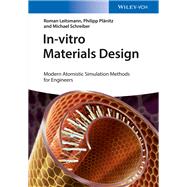
Note: Supplemental materials are not guaranteed with Rental or Used book purchases.
Purchase Benefits
Looking to rent a book? Rent In-vitro Materials Design Modern Atomistic Simulation Methods for Engineers [ISBN: 9783527334230] for the semester, quarter, and short term or search our site for other textbooks by Leitsmann, Roman; Plänitz, Philipp; Schreiber, Michael. Renting a textbook can save you up to 90% from the cost of buying.
Preface IX
Part I Basic Physical and Mathematical Principles 1
1 Introduction 3
2 Newtonian Mechanics and Thermodynamics 5
2.1 Equation of Motion 5
2.2 Energy Conservation 7
2.3 Many Body Systems 10
2.4 Thermodynamics 11
3 Operators and Fourier Transformations 17
3.1 Complex Numbers 17
3.2 Operators 18
3.3 Fourier Transformation 20
4 Quantum Mechanical Concepts 25
4.1 Heuristic Derivation 25
4.2 Stationary Schrödinger Equation 27
4.3 Expectation Value and Uncertainty Principle 28
5 Chemical Properties and Quantum Theory 33
5.1 Atomic Model 33
5.2 Molecular OrbitalTheory 39
6 Crystal Symmetry and Bravais Lattice 47
6.1 Symmetry in Nature 47
6.2 Symmetry in Molecules 47
6.3 Symmetry in Crystals 49
6.4 Bloch Theorem and Band Structure 53
Part II ComputationalMethods 57
7 Introduction 59
8 Classical SimulationMethods 65
8.1 Molecular Mechanics 65
8.2 Simple Force-Field Approach 68
8.3 Reactive Force-Field Approach 71
9 Quantum Mechanical Simulation Methods 77
9.1 Born–Oppenheimer Approximation and Pseudopotentials 77
9.2 Hartree–Fock Method 80
9.3 Density Functional Theory 83
9.4 Meaning of the Single-Electron Energies within DFT and HF 85
9.5 Approximations for the Exchange–Correlation Functional EXC 88
9.5.1 Local Density Approximation 88
9.5.2 Generalized Gradient Approximation 89
9.5.3 Hybrid Functionals 90
9.6 Wave Function Representations 91
9.6.1 Real-Space Representation 91
9.6.2 PlaneWave Representation 92
9.6.3 Local Basis Sets 93
9.6.4 Combined Basis Sets 95
9.7 Concepts Beyond HF and DFT 96
9.7.1 Quasiparticle Shift and the GWApproximation 97
9.7.2 Scissors Shift 99
9.7.3 Excitonic Effects 100
9.7.4 TDDFT 100
9.7.5 Post-Hartree–Fock Methods 101
9.7.5.1 Configuration Interaction (CI) 102
9.7.5.2 Coupled Cluster (CC) 102
9.7.5.3 Møller–Plesset PerturbationTheory (MPn) 103
10 Multiscale Approaches 105
10.1 Coarse-Grained Approaches 105
10.2 QM/MM Approaches 108
11 Chemical Reactions 111
11.1 Transition State Theory 111
11.2 Nudged Elastic Band Method 114
Part III Industrial Applications 117
12 Introduction 119
13 Microelectronic CMOS Technology 121
13.1 Introduction 121
13.2 Work Function Tunability in High-k Gate Stacks 127
13.2.1 Concrete Problem and Goal 127
13.2.2 Simulation Approach 129
13.2.3 Modeling of the Bulk Materials 129
13.2.4 Construction of the HKMG Stack Model 132
13.2.5 Calculation of the Band Alignment 136
13.2.6 Simulation Results and Practical Impact 138
13.3 Influence of Defect States in High-k Gate Stacks 141
13.3.1 Concrete Problem and Goal 141
13.3.2 Simulation Approach and Model System 144
13.3.3 Calculation of the Charge Transition Level 145
13.3.4 Simulation Results and Practical Impact 146
13.4 Ultra-Low-k Materials in the Back-End-of-Line 149
13.4.1 Concrete Problem and Goal 149
13.4.2 Simulation Approach 151
13.4.3 The Silylation Process: Preliminary Considerations 153
13.4.4 Simulation Results and Practical Impact 155
14 Modeling of Chemical Processes 159
14.1 Introduction 159
14.2 GaN Crystal Growth 163
14.2.1 Concrete Problem and Goal 163
14.2.2 Simulation Approach 165
14.2.3 ReaxFF Parameter Training Scheme 166
14.2.4 Set of Training Structures: ab initio Modeling 168
14.2.5 Model System for the Growth Simulations 170
14.2.6 Results and Practical Impact 172
14.3 Intercalation of Ions into Cathode Materials 174
14.3.1 Concrete Problem and Goal 174
14.3.2 Simulation Approach 176
14.3.3 Calculation of the Cell Voltage 178
14.3.4 Obtained Structural Properties of LixV2O5 178
14.3.5 Results for the Cell Voltage 181
15 Properties of Nanostructured Materials 183
15.1 Introduction 183
15.2 Embedded PbTe Quantum Dots 187
15.2.1 Concrete Problem and Goal 187
15.2.2 Simulation Approach 188
15.2.3 Equilibrium Crystal Shape andWulff Construction 190
15.2.4 Modeling of the Embedded PbTe Quantum Dots 191
15.2.5 Obtained Structural Properties 194
15.2.6 Internal Electric Fields and the Quantum Confined Stark Effect 195
15.3 Nanomagnetism 199
15.3.1 Concrete Problem and Goal 199
15.3.2 Construction of the Silicon Quantum Dots 200
15.3.3 Ab initio Simulation Approach 203
15.3.4 Calculation of the Formation Energy 204
15.3.5 Resulting Stability Properties 205
15.3.6 Obtained Magnetic Properties 206
References 211
Index 221
The New copy of this book will include any supplemental materials advertised. Please check the title of the book to determine if it should include any access cards, study guides, lab manuals, CDs, etc.
The Used, Rental and eBook copies of this book are not guaranteed to include any supplemental materials. Typically, only the book itself is included. This is true even if the title states it includes any access cards, study guides, lab manuals, CDs, etc.